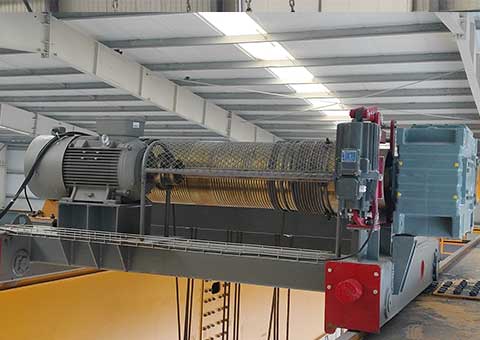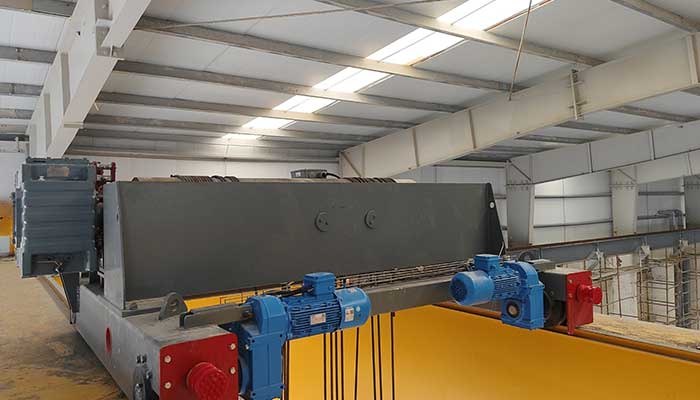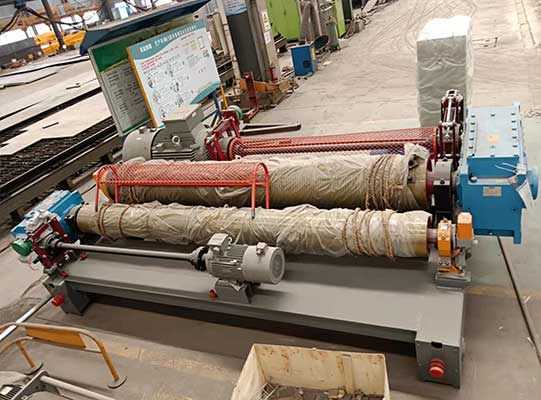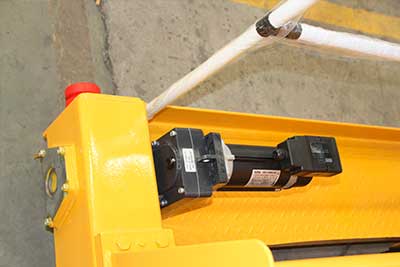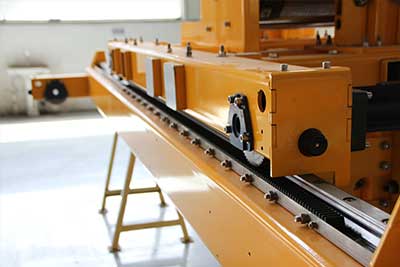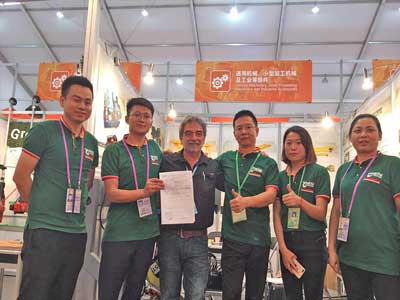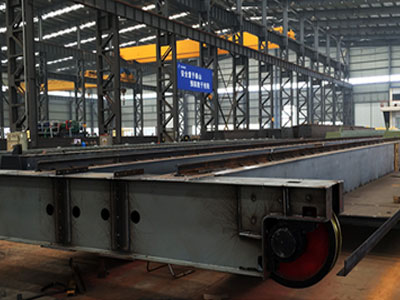Enhance Efficiency and Precision in Industrial Lifting
Built-Up Hoists stand as the pinnacle of innovative lifting mechanisms, offering a tailored approach to address diverse industrial needs. These hoists aren't just lifting systems; they're precision-engineered solutions designed to revolutionize your lifting operations.
Built-up hoists represent meticulously engineered and fully integrated systems primarily deployed on heavy duty cranes. These specialized hoist systems are specifically tailored for process cranes, built with robustness to endure high-output production demands and the rigors of challenging industrial settings. Each built-up hoist system is unique, meticulously customized to suit the specific demands of its intended task.
Advantages of Built-Up Hoists:
- Purpose-Built Components:All components are engineered for specific tasks, ensuring longevity and efficient operation. These systems excel in complex lifting tasks and can endure for over 40 years when properly designed.
- Reliability and Serviceability:More reliable, easier to inspect, and simpler to service and repair compared to package hoist systems. Incorporation of catwalks or service platforms facilitates easy access for maintenance and inspection purposes.
- Ease of Maintenance:Individual grease ports for roller bearings facilitate straightforward lubrication. Design features enable easy access to gearboxes, brakes, and couplings for repair or adjustments.
- Design Advantages in Crane Systems:Found in top-running double girder crane systems, allowing for greater span, capacity, overhead room, and hook height.
- Modern Features and Technologies:Equipped with contemporary features like variable frequency drives, anti-sway technologies, limit switches, remote radio controls, and monitoring systems, enhancing control precision, movement, and safety during load handling.
- Diagnostics and Maintenance Planning:Utilizing diagnostic data enables effective monitoring of hoist component maintenance intervals, facilitating scheduled preventive maintenance to reduce equipment downtime. Predictive maintenance scheduling improves crane safety by identifying when components reach the end of their service life, allowing for necessary repairs or replacements.
Considerations on Built-Up Hoists:
- Cost Factors:Higher cost due to compatibility limitations with top-running double girder crane systems, additional engineering and design requirements, specialized components with longer lead times, increased transportation, freight costs, and complex installation.
- Limited Versatility:Built-Up Hoists are specialized for specific tasks and lack versatility compared to lower duty hoist systems.
- Training and Inspection Challenges:Crane operators and maintenance personnel may require adjustment periods due to differences in performance and controls compared to older package hoist systems. Components' complexity might demand more extensive training or experienced inspectors for regular inspections.
While Built-Up Hoists offer durability, precision, and reliability for complex lifting tasks, they come with higher initial costs, limited versatility, and potential challenges related to operator training and inspection. However, their long-term benefits in reduced maintenance costs and improved efficiency often justify the initial investment in upgraded components and technologies.
Components of a Built-Up Hoist
A built-up hoist comprises a set of sturdy and specialized components meticulously designed to collaborate seamlessly, accomplishing precise and task-specific lifting operations. These components encompass:
- Drums- Drums are cylindrical components around which the wire rope or chain is wound to raise or lower the load. They provide the necessary traction for lifting operations and are designed to withstand the load's weight and movement.
- Motors- Electric motors power the hoist system, providing the necessary force to lift and lower the load. These motors are selected based on power requirements and are critical in determining the hoist's lifting capacity.
- Gearboxes- Gearboxes contain gears that transmit power from the motor to the hoist's drum. They help manage the speed and torque required for lifting while ensuring smooth and controlled movements.
- Couplings- Couplings are used to connect various shafts or components within the hoist system, transmitting torque while compensating for misalignments or vibrations, ensuring smooth operation.
- Sheaves- Sheaves, also known as pulleys, guide the wire ropes or chains, enabling proper alignment and distribution of the load's weight during lifting and lowering operations.
- Encoders- Encoders are devices that provide feedback on the hoist's position and speed, enabling precise control and monitoring of the lifting process, ensuring accuracy and safety.
- Brakes- Brakes are crucial safety components that control the stopping and holding of the load. They provide emergency stopping capabilities and prevent unintended movement during hoisting operations.
- Limit Switches- Limit switches are used to set upper and lower limits for the travel of the hoist, preventing overtravel or collisions. They enhance safety by ensuring that the load remains within specified lifting parameters.
- Drives and Control Systems- Drives and control systems manage the hoist's operation, regulating speed, direction, and acceleration. They facilitate precise control and ensure smooth, accurate, and safe lifting operations.
- Festooning- Festooning comprises cables or hoses that supply power, control signals, and other utilities to the moving parts of the hoist, such as the trolley or crane. They are designed to flex and manage cable movement during crane travel.
Each of these components is meticulously engineered and integrated into the built-up hoist system to function collaboratively, ensuring precision, reliability, and safety during lifting operations. Their seamless coordination allows for task-specific and precise handling of loads in a wide array of industrial applications.
The majority of these components undergo precision machining to adhere to exacting tolerances, ensuring the ability to execute complex or critical lifts repeatedly. Materials employed in built-up hoists are often of high alloy, heat-treated or hardened, and precision-welded to mitigate stress, fatigue, and distortion within the system. This robust construction ensures durability and reliability, even in demanding operational conditions.
Versatility in Design, Unmatched in Performance
Built-Up Hoists are meticulously crafted by assembling high-quality components, ensuring durability and reliability in the most demanding environments. Their versatility shines through various types - from Electric Built-Up Hoists offering precise control to Wire Rope Build-Up Open Winch Hoists delivering robust lifting capabilities. Each variant is designed to excel in specific industrial applications, ensuring optimal performance with efficiency.
- Automation-Built-Up Hoists play a pivotal role in automated manufacturing processes. They enable the precise lifting and movement of materials and components in automated production lines, enhancing efficiency and reducing manual handling requirements.
- Bucket Hoists-Utilized in industries such as mining and construction, bucket hoists efficiently lift and transport materials in large buckets, contributing to excavation, transportation, and material handling tasks.
- Ladle and Charging Hoists-Crucial in steelmaking facilities, ladle and charging hoists are employed for lifting molten metal ladles and charging raw materials into furnaces, ensuring continuous operations and optimized steel production.
- Explosion-Proof Hoists-Industries dealing with combustible or hazardous environments, such as chemical plants or oil refineries, rely on explosion-proof hoists to safely handle materials and equipment, minimizing the risk of ignition and ensuring worker safety.
- Magnet Services-Built-Up Hoists equipped with magnets are widely used in metalworking industries for handling ferrous materials, facilitating efficient sorting, lifting, and movement of metal components or scraps.
- Wet and Dry End Paper-Mill Services-In paper manufacturing, Built-Up Hoists assist in the handling of paper rolls, pulp, and machinery, contributing to both wet and dry end paper mill operations, ensuring smooth production processes.
- Turbine Handling-In power generation plants, Built-Up Hoists are instrumental in handling turbine components, facilitating their assembly, installation, and maintenance within power generation systems.
- Critical Lifts-Industries requiring precise and highly controlled lifting operations, such as aerospace or nuclear facilities, rely on Built-Up Hoists for critical lifts involving delicate or sensitive equipment.
- Die Flipping and Metal Coil Handling-Manufacturing sectors, particularly automotive and metalworking industries, utilize Built-Up Hoists for flipping dies and handling heavy metal coils, contributing to efficient production processes.
These applications demonstrate the versatility of Built-Up Hoists across various industries, enabling efficient and precise lifting operations in diverse and challenging environments.
Service Advantages
Principle of Prompt Response
Quality issues reported by customers must be responded to within 4 hours;
- For significant issues, technical service personnel must arrive at the site within 24 hours;
- All departments must assist customers in solving problems at the earliest opportunity for any quality issues.
Value-Added Service Principle
While customers enjoy our company's products, we actively provide technical support, recommend new products, and provide the latest market information, aiming to maximize customer benefits and provide a sense of value-added service.
Customer Engagement Principle
We sincerely invite customers to visit our company, understand the product manufacturing process, experience our company's culture, management, and current status, openly accept customer suggestions, and actively and effectively improve our work.
Our Services
- Pre-sales Service - Provide free technical consulting services to users; Provide users with product samples, company profiles, credit certificates, and other materials; Invite users to visit our company to inspect product design, process, and quality management systems; Delegate technical personnel to provide free design and selection according to on-site conditions and user needs.
- Mid-sales Service-During the product manufacturing process, invite technical personnel from users to inspect the inspection of various processes and provide them with inspection standards and results.
- After-sales Service-Conduct technical training based on user needs, promptly improve products according to user needs; strictly implement the "three guarantees" service policy for products; Resolve customer issues within 8 hours, with service engineers on standby for 24 hours. If faults are not resolved, service engineers cannot leave the site without customer permission.
Your Partner in Elevating Operations
At Yuantai Crane, we specialize in delivering cutting-edge Built-Up Hoists that redefine lifting standards. Our team of experts is dedicated to understanding your unique lifting needs and providing tailored solutions that maximize efficiency, safety, and productivity in your operations.
Embrace precision, reliability, and versatility in your lifting operations with our range of Built-Up Hoists. Elevate your industrial endeavors to new heights with our innovative solutions.
